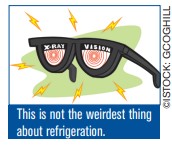It’s said that an engineer only needs two things in his toolkit: duct tape and WD-40. If something moves and it shouldn’t—duct tape! If doesn’t move but it ought to—WD-40. If it should move and does, or shouldn’t and doesn’t, leave it alone. I’ve long believed that the refrigeration engineer needs a third vital weapon in his armory: X-ray specs.
These were commonly seen in the ad pages of the comics I read as a boy, offering “loads of laughs and fun at parties” and backed by a “Money Back Guarantee.” I was never persuaded to part with my $1.00 (plus $0.25 shipping) but it has struck me many times when I’ve heard of accidents on site or equipment that just didn’t work as expected that these gadgets would be a boon to the refrigeration business.
The problem with refrigeration is that we calibrate our understanding on the basis of what is familiar. We understand fluid flow because water is all around us and we interact with it daily (at least I hope we do). This calibration serves us well in daily life but doesn’t account for the weirdness of fluids in a sealed space— i.e., a refrigeration system. Here are a few examples of surprising oddities in refrigeration.
When pumping out a system before maintenance, if the pressure drops to atmospheric and no more gas comes out, it must be empty, right? Wrong! Liquid refrigerant, especially with a high latent heat like ammonia, will get very cold inside the system and lie in low lying areas. Carbon dioxide is even more tricky; it will solidify if the pressure drops below 63 psig (4.2 bar g) and then gas off gradually. A design tip is to include a service valve at the lowest point of a pipe section likely to require to be opened in order to enable a temporary line to be connected for the transfer of liquid refrigerant under pressure to another part of the system.
In another dangerous scenario a length of a discharge line was isolated on a screw compressor package on a Friday in wintertime. It was verified to be vented and then resealed for the weekend. On Monday morning after a very cold weekend, the bolts around the discharge check valve were loosened and a high pressure jet of liquid ammonia sprayed out. The low temperature over the weekend caused low pressure in the sealed section which sucked gas from the system discharge (still at operating pressure) and condensed it in the sealed space. I had a similar experience when removing the seal cap on a shut-off valve. Fortunately for me the squirt of liquid shot away from me.
Once, a non-performing evaporator had horizontal circuits and was apparently feeding both subcooled liquid and superheated gas to the suction line, which ought to be impossible. The gas velocity wasn’t high enough to distribute liquid up the walls of the stainless steel tubes, and the thermal conductivity of the tube wall was too low to conduct heat into the stream of liquid flowing along the bottom of the tube. Likewise, in the suction of a compressor droplets of liquid can coexist with superheated gas because the surface tension of droplets inhibits evaporation.
Sadly, real X-ray specs are not coming any time soon. We just need to harness our imaginations and visualize what might be happening inside those pipes.

